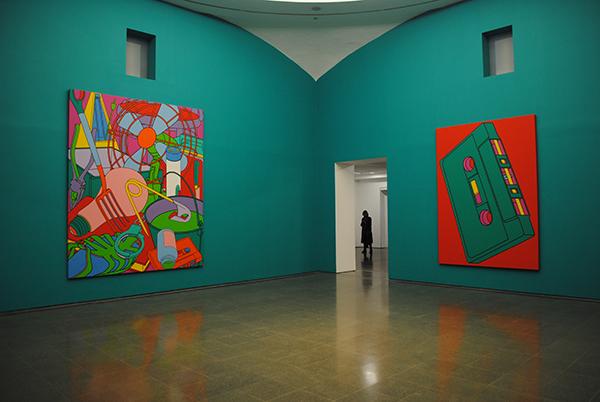The Serpentine is currently presenting an exhibition by Michael Craig-Martin; the first solo show of the artist’s work in a London public institution since 1989 and brings together works from 1981 to 2015. Craig- Martin presents his trademark impersonality in the form of obsolete technology; slick, glowing, and intentionally flat.
The Serpentine gallery presents the artist in a timely fashion – paintings like hyper-real Christmas decorations – the artist is super cool and intentionally shallow. The focus is on redundant technology; the transience of objects and the immediacy of soulless representation. ‘Anyone’ can paint like this: is the intentional position of the work, reflecting the empty nature of one of his student’s spot paintings.
 Image: Michael Craig-Martin’s Transience at the Serpentine Gallery. Photo: P A Black © Artlyst 2015.
Image: Michael Craig-Martin’s Transience at the Serpentine Gallery. Photo: P A Black © Artlyst 2015.
Generic art that has in fact placed Craig-Martin apart – aside from being the creator of the YBA’s and the most notorious of ‘enfant terribles’ – the artist is renowned for exploring the conceptual boundaries of contemporary art. Here Craig-Martin depicts the utter rationalisation of the depiction of the object. The painting is the ultimate in reductiveness; the language has been stripped back, attempting the ultimate in clarity and simplification.
This is the representation of technology as Pop Art-esque iconography in blazing pinks and ultra-cool blues; the artist’s work is instantly placed in its own time via the tech represented, a nostalgic journey through the blank and shadowless world of stylisation, temporal snippets from our past presented with the intentionally empty panache of Warhol.
The successive generations of objects are depicted through a language best described as a democratic mundanity, surely a language reflecting our age? The epitome of the axiomatic image, the artist presents the nostalgic via uniformity, this is all about function, of the object and indeed the painting; literally and metaphorically both hot and cold, although intentionally presenting a vivid emptiness, and a minimalism, the work’s neon graphic quality still fizzes with the electricity of the redundant tech presented. In comparison Warhol’s colours have faded with time; no one does colour quite like Craig-Martin.
About the artist:
Michael Craig-Martin (b.1941, Dublin, lives and works in London) Selected solo exhibitions include: NOW, Shanghai Himalayas Museum, Shanghai, China (2015); Michael Craig-Martin at Chatsworth, Chatsworth House, Derbyshire, UK (2014), Less Is Still More, Museum Haus Esters, Krefeld, Germany (2013); Michael Craig-Martin. New Painting and Sculpture, Roche Court, Wiltshire, UK (2011), Signs of Life, Kunsthaus Bregenz, Germany and Works 1964–2006, IMMA, Dublin, Ireland (both 2006); Haus der Kunst, Munich, Germany and fig-2, ICA, London, UK (both 2000) and A retrospective 1968–1989, Whitechapel Art Gallery, London, UK (1989).
Selected group exhibitions include: Summer Exhibition 2015, (chief coordinator) Royal Academy of Arts, London, UK (2015); The Indiscipline of Painting, Tate St Ives, UK (2011); Forgetting Velázquez: Las Meninas, Museu Picasso de Barcelona, Spain (2008); Intelligence, New British Art 2000, Tate Britain, London, UK (2000); Documenta VI, Kassel, Germany (1977) and The New Art, Hayward Gallery, London, UK (1972).
Craig-Martin is represented within public collections, including Tate, London, UK; Museum of Modern Art, New York, USA; Centre Georges Pompidou, Paris, France; and Museo Nacional Centro de Arte Reina Sofia, Madrid, Spain. He was appointed a CBE in 2001 and elected a Royal Academician in 2006.
Lead image: Michael Craig-Martin’s Transience at the Serpentine Gallery. Photo: P A Black © Artlyst 2015.
Words: Paul Black. Photos: P A Black © Artlyst 2015.
Michael Craig-Martin: Transience – Serpentine Gallery – until 14 February 2016.

